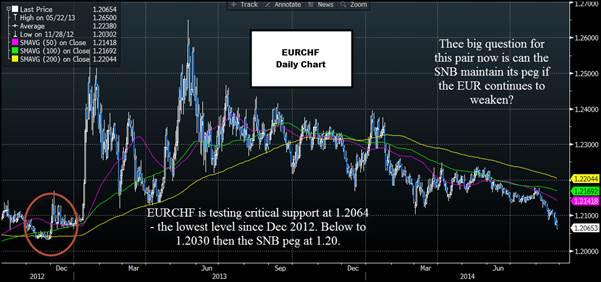![]()
Since the Swiss National Bank (SNB) imposed its peg in EUR/CHF, this cross has only traded below 1.20 a handful of times, and each time it has bounced off this important level of support. In the three years that the peg has been in place, the market hasn’t tested the SNB’s resolve with any gusto. The market has seemed to accept that you don’t push EUR/CHF below 1.20, otherwise the SNB will act and you could get burnt.
The SNB has kept its commitment to the peg, however, if the ECB embarks on a programme of quantitative easing in the coming months, as some expect, then it could become a lot more expensive for the SNB to defend the 1.20 level if the EUR weakens substantially from here.
If the SNB was to pull the plug on the peg then there could be a sharp reaction in EUR/CHF as pent up demand could trigger fresh shorts below the 1.20 level. However, we continue to think that the SNB will do everything that it can to defend the 1.20 level. Swiss inflation is already at 0%, and a stronger CHF would only make this deflationary problem worse. The Swiss authorities have been increasing their foreign exchange reserves, which are now at their highest ever level, at CHF 453bn. This is quite a war chest and suggests that the SNB won’t give up the peg without a fight.
The technical view:
EUR/CHF is testing a critical level of support after a sharp sell-off in recent days. 1.2064 is the low from 31st December 2012. A break below this level would be a further negative trending/ momentum indicator and could pave the way for more downside towards 1.2030 – the November 2012 low, which then leads the way to 1.20 – the SNB’s peg.
While we think that there could be room for a test of 1.20, any move back towards 1.1980- 1.2020 could be met with a wave of EURCHF strength. If that happens, it is likely to be the work of the SNB. Since the market has respected the SNB peg for most of the last 3 years, we would be surprised if there isn’t some trepidation around this level. We think there will be plenty of buy orders around 1.1980- 1.2020 as the market tries to jump on the back of a wave of EURCHF buying.
Thus, in the short term, there could be 60 pips or more of further downside, but around 1.20 we could see a sharp reversal as the SNB tries to get EUR/CHF out of harm’s way, so be careful of crossing the SNB at this important level. Key resistance lies at 1.2112 – the 38.2% retracement of August’s decline.
CFD’s, Options and Forex are leveraged products which can result in losses that exceed your initial deposit. These products may not be suitable for all investors and you should seek independent advice if necessary.
Recommended Content
Editors’ Picks
AUD/USD could extend the recovery to 0.6500 and above

The enhanced risk appetite and the weakening of the Greenback enabled AUD/USD to build on the promising start to the week and trade closer to the key barrier at 0.6500 the figure ahead of key inflation figures in Australia.
EUR/USD now refocuses on the 200-day SMA

EUR/USD extended its positive momentum and rose above the 1.0700 yardstick, driven by the intense PMI-led retracement in the US Dollar as well as a prevailing risk-friendly environment in the FX universe.
Gold struggles around $2,325 despite broad US Dollar’s weakness

Gold reversed its direction and rose to the $2,320 area, erasing a large portion of its daily losses in the process. The benchmark 10-year US Treasury bond yield stays in the red below 4.6% following the weak US PMI data and supports XAU/USD.
Bitcoin price makes run for previous cycle highs as Morgan Stanley pushes BTC ETF exposure

Bitcoin (BTC) price strength continues to grow, three days after the fourth halving. Optimism continues to abound in the market as Bitcoiners envision a reclamation of previous cycle highs.
US versus the Eurozone: Inflation divergence causes monetary desynchronization

Historically there is a very close correlation between changes in US Treasury yields and German Bund yields. This is relevant at the current juncture, considering that the recent hawkish twist in the tone of the Federal Reserve might continue to push US long-term interest rates higher and put upward pressure on bond yields in the Eurozone.
